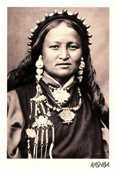Home
KASHBA Asiatica
Ais Loupatty
Ton Lankreijer
Staalstraat 6
1011 JL Amsterdam
Open 12:00 – 17:00
Zondag / Sunday 14:00 - 17:00
GESLOTEN / CLOSED
16 okt - 5 nov '25
Contact:
31-20 - 6 23 55 64
06 - 588 41 370
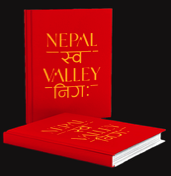

Especially in the past couple of decades, quite a few scattershot books about art, antiques or ethnography appeared. More suited for browsing than for serious reading.
Often they were based on just as randomly composed private collections. With a stout book they had to be pimped-up internationally – for a possible sale or some tax construction.
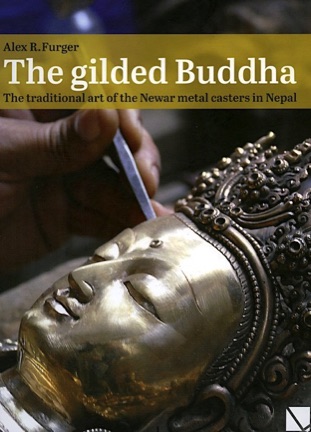
Every once in a while, a thorough study with attractive, relevant photo material appeared. Books that at once belonged to the standard works and made many others superfluous.
The gilded Buddha, however, goes further. It not only shows why Newarese craftsmanship in the field of metalwork has belonged to the best in the world for centuries, it is also a clear and illustrative reference work with the required analyses of alloys or formulas for patination.
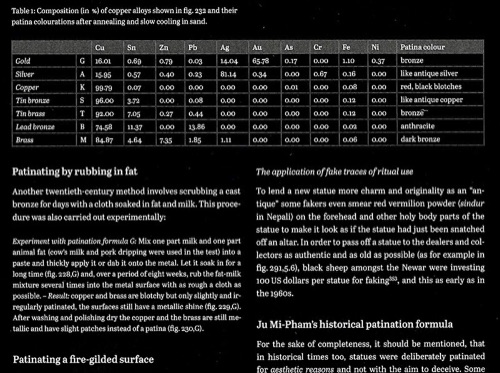

Art connoisseurs, curators and antique dealers rarely indicate clearly what a statue was made of. Brass, bronze or copper..?
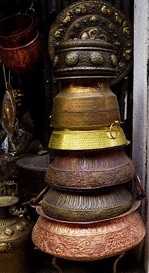
It makes a huge difference – also in price. Bronze may be expensive at the metal dealer, but copper is much more expensive at the foundry.
The experts, however, routinely calculate 'the value’ according to their iron formula: who, where and especially when. It is their rusty cliché to translate art into money: unicity versus copy.
Anyone who studies the lost wax method in The gilded Buddha, however, understands that the term 'copy' is often used as an improper label – to make something else more exclusive. (See porcelmania.)

'Spontaneity can only take shape when you master the technique,' a befriended artist invariably mumbles when he sees expressions of all too impetuous creative drive.
However, knowledge of the technology applied is of great importance for the buyer as well.
Even in today’s consumer society in which almost no one looks under the hood anymore. Sellers do not want ‘to bother the customer with it’. Or to
Yet the only correct slogan still is: the more you know, the more you see.
By knowing the applied technique you better understand what you are looking at ... and whether the sales pitch is any true.
Embossing, lost wax casting, fire-gilding, patinating, chiseling… The gilded Buddha painstakingly and thoroughly explains with text and pictures.
As a result, the book extends far beyond the ancient Newarese craftsmanship.

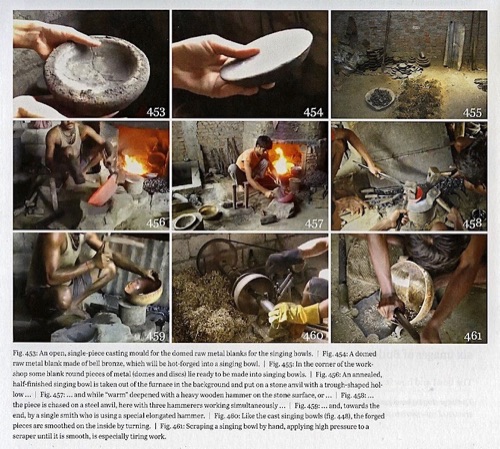
Many Chinese, Tibetan or Indian images were once made by artistic craftsmen from the Kathmandu valley. Nobody knows why particularly the Newari became such masters in metalworking. (Just as it has never been clearly established why their language has so many Burmese-Tibetan influences.)
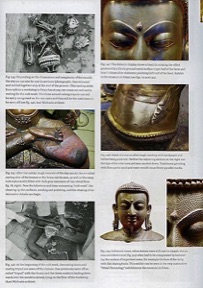
Did their own stupa and temple shapes lead to it and vice versa? Or was it due to the demand of distant monasteries: 'Where can we find a family business that can make 1008, 10.008 or 100.008 of the same Avalokiteshvara figurines during the next few decades to half a century?'
Fact is that they were invited to far away areas.
One of them even designed the ‘typically Chinese' five-roofs temple tower.

Reading The gilded Buddha, one understands why it takes roughly half a year before, for example, the Tara image (left) has been created:
modeling, making mold, casting, freeing and repairing the cast, welding, chiseling, engraving, patinating…
Investing so much time and energy into a statue that still needs to be sold is risky. Especially if you need to support a family going to school, needing a smartphone (as a computer) and all the rest that modern times and globalization
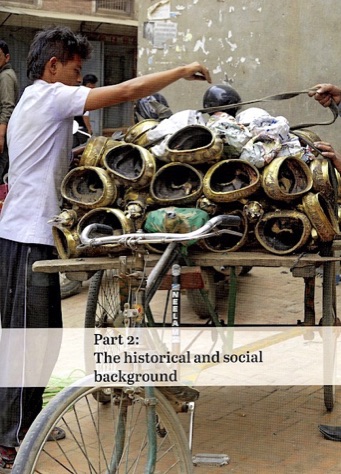
Another factor changing the craft - if not causing its extinction - is that it consequently slides from art to mass production. With the associated environmental pollution.
Perhaps this book will contribute to the reversal of this process when recognition of the quality will make people willing to pay for it.

PS: The heavy 328-page, hardcover book was printed in Memmingen (Germany) and came about thanks to foundations and anonymous philanthropists.
The gilded Buddha costs € 85, =
Because bookstores usually do not stock it and because order & delivery take time and effort, we keep a number of copies in store. That is to say: the English version.
The original title is Der vergoldete Buddha.
PPS: For different techniques in various cultures, also see: casters and carvers.

put it less friendly: they prefer to keep the buyer stupid. Open a device and you have lost the guarantee.
demands.
However, if you sign up as a contract worker to Arab countries, you have a minimal yet steady income for five years or longer.
23 apr. 2018 17:52
All photographs and texts ©Kashba Ais Loupatty & Ton Lankreijer.Webdesign:William Loupatty
